Reviewed and fact-checked by way of Sayantoni Das
Information is the forex of commercial, permitting smarter decision-making in line with granular knowledge. Probably the most main equipment for making sense of information in a trade environment is Tableau, which allows interactive, data-based visualizations. As data-centric trade processes proceed to take cling, the call for for Tableau execs develop too. And with the intention to get into such a challenging fields, cracking the ones fierce tableau interview questions is paramount!
On this article you’re going to be informed a chain of Tableau interview questions (and solutions) chances are you’ll come upon should you’re interviewing for a task the usage of Tableau. Reviewing those Tableau interview questions and solutions will assist you to ace your Tableau interview in a single move!
The video underneath will take you via probably the most maximum requested Tableau interview questions and solutions to help you get ready in your subsequent interview.
Maximum Requested Tableau Interview Questions
1. What’s Tableau?
Tableau is a formidable records visualization device that permits customers to connect with more than a few records assets, create interactive dashboards, and generate insightful experiences. Tableau is the Trade Intelligence (BI) trade’s maximum potent and quickest device for visualising records. It turns the uncooked records right into a layout this is simple to grasp. Tableau makes it quicker to have a look at the knowledge. Dashboards can be utilized to create visualisations. Information visualisations or diagrams make it simple for workers in any respect ranges of an organisation to grasp the tips.
2. What are the other records connection choices to be had in Tableau?
Tableau supplies more than a few records connection choices, together with Excel spreadsheets, textual content information, databases (equivalent to SQL Server, Oracle, MySQL), and internet records connectors.
3. How are you able to create a calculated box in Tableau?
To create a calculated box in Tableau, you’ll be able to right-click within the records pane, make a selection “Create Calculated Box,” after which input the required method or expression the usage of Tableau’s calculation syntax.
4. What’s the distinction between a size and a measure in Tableau?
In Tableau, a size is a specific or qualitative variable that represents the traits or attributes of the knowledge, whilst a measure is a quantitative or numerical variable that may be aggregated or summarized.
5. How are you able to create a dashboard in Tableau?
A tableau dashboard is a last step in developing the visualisation. First, make the entire charts in separate sheets. Then, click on “upload new dashboard” within the tab the place you upload new worksheets. You’ll additionally right-click at the “Upload new sheet” button and select “Upload new dashboard” as an alternative of “sheet.” To create a brand new dashboard in a different way, click on Dashboard within the toolbar. As soon as you will have executed a kind of 3 issues, you can be dropped at a brand new dashboard the place you’ll be able to start piecing in combination your tale by way of dragging the related sheets from the left panel onto the dashboard in my opinion.
6. What’s records mixing in Tableau?
Information mixing is a method in Tableau that permits you to mix records from a number of records assets in line with a not unusual box or key. It lets you analyze and visualize records that is living in numerous databases or information. Information mixing is a extra complex approach of mixing two other records assets. For instance, one records supply presentations the yearly gross sales of a product in different international locations, and every other presentations the cash in and loss for every nation every month. Other ranges of segregation imply {that a} easy sign up for may not paintings on this case. Step one might be so as to add up the entire values in the second one records supply in line with the 12 months. After that, a sign up for might be executed. Tableau makes it really easy to do all of those steps as a result of Tableau can to find the sphere of nation and 12 months this is shared by way of two records assets and do a post-aggregate sign up for by itself.
7. What’s the goal of a parameter in Tableau?
Parameters in Tableau permit customers to outline dynamic values that can be utilized to keep watch over more than a few sides of the visualization, equivalent to filtering records, converting calculations, or enhancing colours.
8. How are you able to carry out records aggregation in Tableau?
Tableau supplies more than a few aggregation purposes, equivalent to SUM, AVG, MAX, MIN, COUNT, and many others., which can also be implemented to measure fields. To accomplish aggregation, you’ll be able to drag a measure box to the visualization and select the required aggregation serve as.
9. What are the various kinds of charts to be had in Tableau?
Tableau gives quite a lot of charts, together with bar charts, line charts, pie charts, scatter plots, maps, treemaps, warmth maps, and extra. Every chart kind is acceptable for various kinds of records and research functions.
10. How are you able to proportion your Tableau workbooks with others?
Tableau supplies a number of choices to proportion your workbooks, equivalent to publishing them to Tableau Server or Tableau Public, exporting them as symbol information or PDFs, or developing interactive Tableau tales that may be shared as internet hyperlinks.
Tableau Interview Questions for Novices
11. What Are the Information Varieties Supported in Tableau?
Following records sorts are supported in Tableau:
- Textual content (string) values
- Date values
- Date and time values
- Numerical values
- Boolean values (relational most effective)
- Geographical values (used with maps)
12. How Will You Perceive Dimensions and Measures?
|
Dimensions |
Measures |
|---|---|
|
|
13. What’s Intended by way of ‘discrete’ and ‘steady’ in Tableau?
Tableau represents records relying on whether or not the sphere is discrete (blue) or steady (inexperienced).
- Discrete – “in my opinion separate and distinct.”
- Steady – “forming an unbroken complete with out interruption.”
The values are as proven:
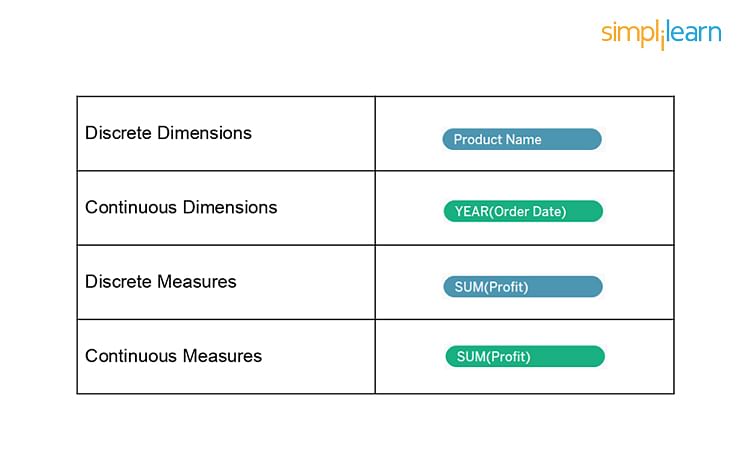
14. What Are the Filters? Title the Other Filters in Tableau.
This is likely one of the maximum often Tableau interview questions. And also you should take a look at giving a radical solution to this one! Tableau filters are some way of proscribing the content material of the knowledge that can input a Tableau workbook, Tableau dashboard, or view.
The Other Kinds of Tableau Filters are:
- Extract filters
- Context filters
- Information supply filters
- Filters on measures
- Filters on dimensions
- Desk calculation clear out
15. There Are 3 Buyer Segments within the Superstore Dataset. What % of the Overall Income Are Related to the Company Section?
Practice those steps:
- Drag phase box to the rows shelf. Right here, phase is composed of Client, Company, and House Workplace
- Double-click at the cash in box below Measures.
- Proper-click on SUM (Benefit) below marks card, make a selection Fast Desk Calculation and click on on % of the full.
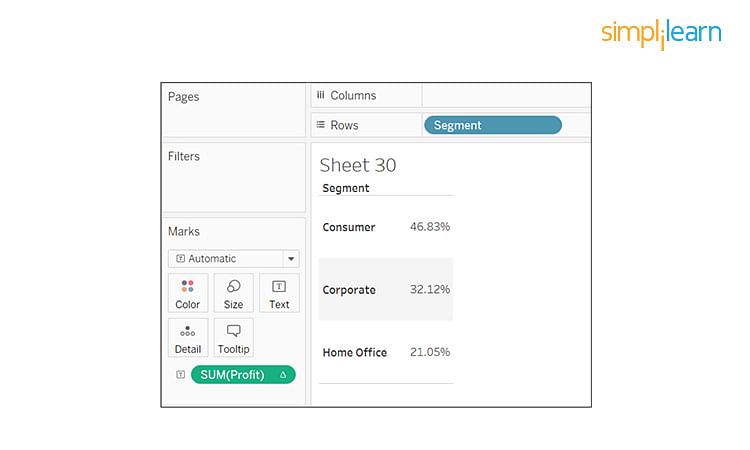
Having a look above, the company phase has 32.12 p.c of the full earnings.
Tableau Interview Questions for Skilled
16. What Are the Other Joins in Tableau?
Becoming a member of is a technique for combining comparable records on a not unusual key. Beneath is a desk that lists the various kinds of joins:


17. What’s the Distinction Between Becoming a member of and Mixing?
Combining the knowledge from two or extra other assets is records mixing, equivalent to Oracle, Excel, and SQL Server. In records mixing, every records supply comprises its personal set of dimensions and measures.
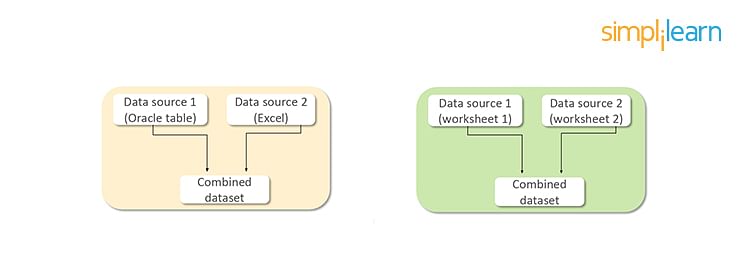
Combining the knowledge between two or extra tables or sheets inside the similar records supply is records becoming a member of. All of the mixed tables or sheets include a not unusual set of dimensions and measures.
Additionally Learn: Most sensible SQL Server Interview Questions And Solutions
18. What’s the Distinction Between a Are living Connection and an Extract?
That is every other often requested Tableau interview query. Tableau Information Extracts are snapshots of information optimized for aggregation and loaded into machine reminiscence to be temporarily recalled for visualisation.
Instance: Hospitals that track incoming affected person records want to make real-time choices.
Are living connections be offering the benefit of real-time updates, with any adjustments within the records supply mirrored in Tableau.
Instance: Hospitals want to track the affected person’s weekly or per 30 days developments that require records extracts.
Did You Know?
While you create an extract of the knowledge, Tableau does not want get right of entry to to the database to construct the visualization, so processing is quicker.
If in case you have a Tableau server, the extract possibility can also be set to a refresh time table to be up to date.
19. What’s a Calculated Box, and How Will You Create One?
A calculated box is used to create new (changed) fields from current records within the records supply. It may be used to create extra tough visualizations and doesn’t have an effect on the unique dataset.
For instance, let’s calculate the “reasonable prolong to send.”
The knowledge set thought to be right here has knowledge relating to order date and send date for 4 other areas. To create a calculated box:
- Move to Research and make a selection Create Calculated Box.
- A calculation editor pops up at the display. Supply a reputation to the calculated box: Transport Lengthen.
- Input the method: DATEDIFF (‘day’, [Order Date], [Ship Date])
- Click on on Good enough.
- Convey Transport Lengthen to the view.
- Repeat steps 1 to five to create a brand new calculated box ‘Reasonable Transport Lengthen’ the usage of the method: AVG (DATEDIFF (‘day,’ [Order Date], [Ship Date]))
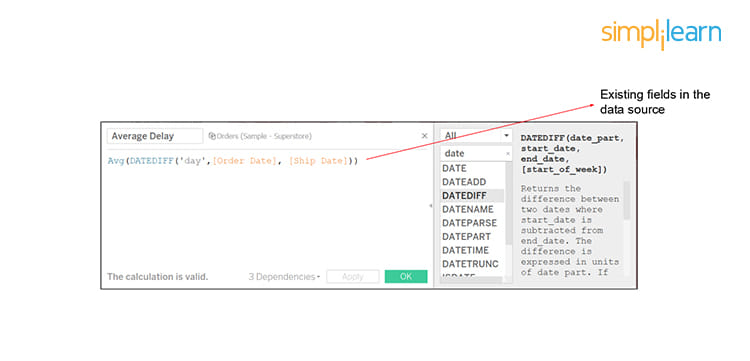
- Drag Area box to Rows shelf and SUM(Reasonable Transport Lengthen) to the marks card; the typical prolong for every area will get displayed.
20. How Can You Show the Most sensible 5 and Backside 5 Gross sales within the Similar View?
We will show it the usage of the In/Out capability of units.
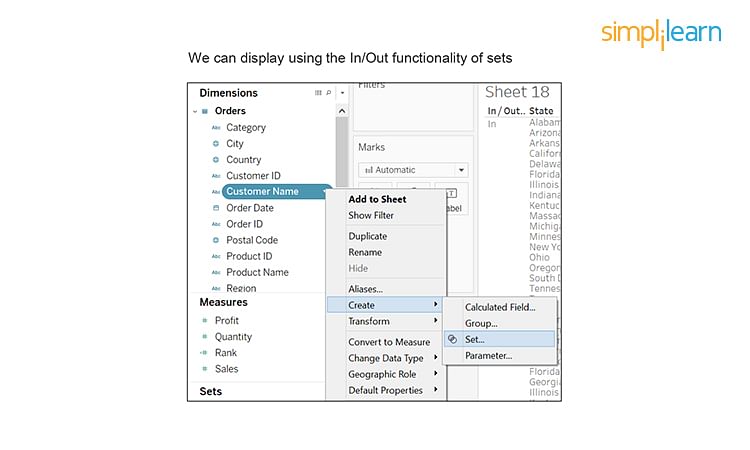
Practice those steps:
- Drag the Buyer Title box to Rows shelf and Benefit box to Columns shelf to get the visualization.
- Create a suite by way of right-clicking at the Buyer Title box. Select to create an possibility and click on on Set.
- Give you the title ‘Most sensible Consumers’ to the set. Configure the set by way of clicking on Most sensible tab, deciding on By means of box, and filling the values as Most sensible, 5, Benefit, and Sum.
- In a similar way, create a 2d set referred to as ‘Backside Consumers’ and fill the By means of Box values as Backside, 5, Benefit, and Sum.
- Choose those two units and right-click on it. Use the choice Create Mixed Set. Title it ‘Most sensible and Backside Consumers’ and come with all participants of each units. Pull the Most sensible and Backside Consumers onto Filters.
The highest 5 and backside 5 are displayed:
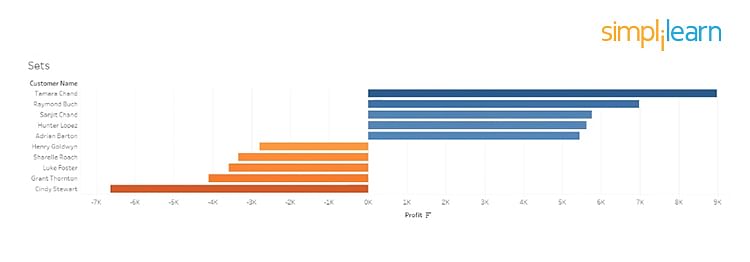
21. Is There a Distinction Between Units and Teams in Tableau?
A Tableau team is one dimensional, used to create a better point class by way of the usage of lower-level class participants. Tableau units will have stipulations and can also be grouped throughout a number of dimensions/measures.
Instance: Sub-category can also be grouped by way of class.
Most sensible Gross sales and cash in can also be clubbed in combination for various classes by way of developing a suite:
- Proceeding with the above instance of Units, make a selection the Backside Consumers set the place buyer names are organized in line with cash in.
- Move to the ‘Teams’ tab and make a selection the highest 5 entries from the checklist.
- Proper-click and make a selection create a bunch possibility.
- In a similar way, make a selection the ground 5 entries and create their team. Conceal the entire different entries.

A key distinction this is that the teams will encompass the similar consumers despite the fact that their earnings exchange later. Whilst for units, if the cash in adjustments, the highest 5 and backside 5 consumers will exchange accordingly.
Did You Know?
We will’t use teams in calculated fields, however we will be able to use units.
22. What’s a Parameter in Tableau? Give an Instance.
A parameter is a dynamic cost {that a} buyer may make a selection, and you’ll be able to use it to exchange consistent values in calculations, filters, and reference strains.
For instance, when making a clear out to turn the highest 10 merchandise in line with general cash in as an alternative of the mounted cost, you’ll be able to replace the clear out to turn the highest 10, 20, or 30 merchandise the usage of a parameter.
Proceeding with the similar instance of top-five and backside 5 consumers, apply those steps:
- Choose the drop-down arrow at the height correct nook of the Information pane.
- Click on on Create Parameter and fill in the main points:
- Title – Collection of height/backside consumers
- Choose ‘Vary’ for Allowable Values and fill the fields as:
- Minimal – 5
- Most – 20
- Step – 5
- Edit the set ‘Most sensible Consumers’ by way of converting the ‘By means of Box’ cost of five with ‘Choose selection of height/backside consumers.’ Do the similar adjustments within the ‘Backside Consumers’ set.
- Move to the created parameter at the Information pane, right-click on it and make a selection ‘Display Parameter Keep watch over.’ Now, should you build up the step throughout the vary, the knowledge seems as in keeping with the parameter cost set.
Following is the visualization for a step dimension of 10:
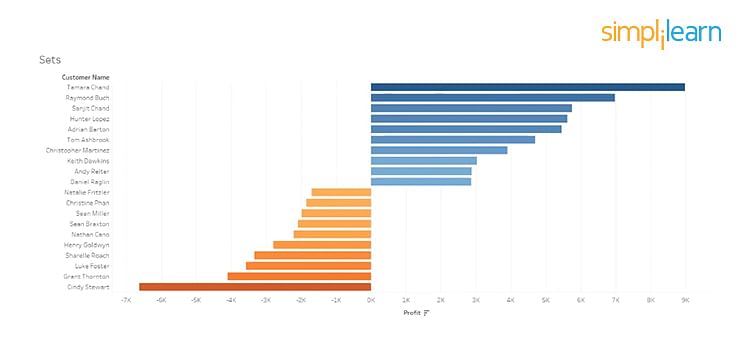
23. What’s the Distinction Between Treemaps and Warmth Maps?
Warmth Maps
A Warmth map is used to match classes the usage of colour and dimension. On this, we will be able to distinguish two measures.
State of affairs: Display gross sales and cash in in all areas for various product classes and sub-categories.
Practice those steps:
- Drag Area box to Columns shelf, and Class and Sub-Class fields in Rows shelf.
- Use the ShowMe device and make a selection the Warmth Map.
- Apply the warmer and chillier areas within the warmth map produced:
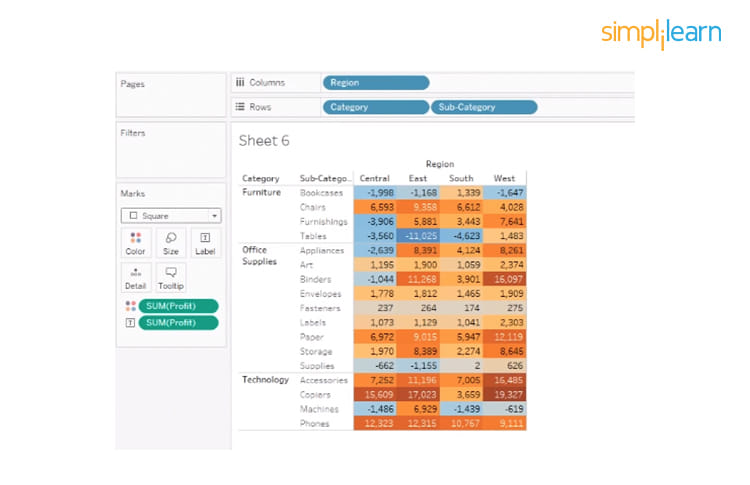
A warmth map isn’t just outlined by way of colour, however you’ll be able to additionally use its dimension. Right here we outline the scale by way of sale by way of dragging the Gross sales tab to Dimension below marks card, evaluating cash in and gross sales throughout the colour and dimension.

Research: Benefit is represented by way of colour and levels from orange for loss to blue for cash in. The whole gross sales are represented by way of dimension.
Tree Maps
A Treemap is used to constitute hierarchical records. The gap within the view is split into rectangles which are sized and ordered by way of a measure.
State of affairs: Display gross sales and cash in in all areas for various product classes and sub-categories.
- Choose two dimensions Class and Sub-Class
- Choose two measures Gross sales and Benefit from the knowledge pane.
- Use the Display-me device and make a selection tree-map.
That is the way it appears to be like:
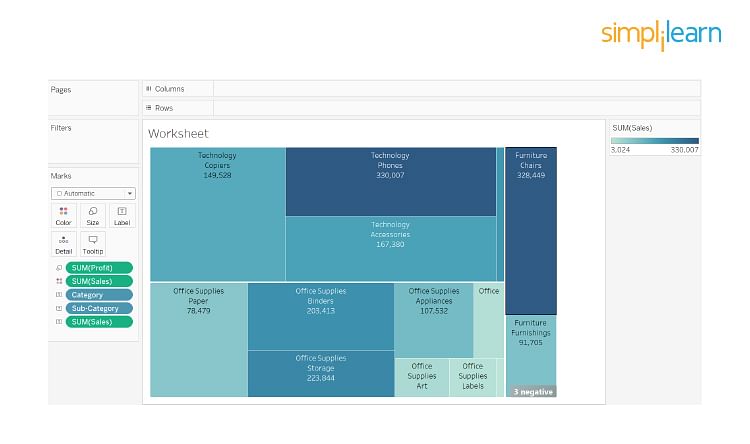
Research: The bigger the scale of the node, the upper the cash in in that class. In a similar way, the darker the node, the extra gross sales in that class.
24. What’s the Distinction Between .twbx And .twb?
This is likely one of the maximum often requested Tableau interview questions, and also you should solution this one intimately.
.twbx
The .twbx comprises the entire important knowledge to construct the visualization in conjunction with the knowledge supply. This is known as a packaged workbook, and it compresses the package deal of information altogether.
.twb
The .twb comprises directions about the right way to engage with the knowledge supply. When it is development a visualization, Tableau will have a look at the knowledge supply after which construct the visualization with an extract. It may’t be shared by myself because it comprises most effective directions, and the knowledge supply must be connected one by one.
25. Give an explanation for the Distinction Between Tableau Worksheet, Dashboard, Tale, and Workbook?
- Tableau makes use of a workbook and sheet document construction, similar to Microsoft Excel.
- A workbook comprises sheets, which could be a worksheet, dashboard, or a tale.
- A worksheet comprises a unmarried view in conjunction with cabinets, legends, and the Information pane.
- A dashboard is a selection of perspectives from a number of worksheets.
- A tale comprises a series of worksheets or dashboards that paintings in combination to put across knowledge.
Additionally Learn: Tableau Dashboard: Your One-Prevent Answer For The Dashboards In Tableau
|
To find Our Tableau Coaching in Most sensible Towns |
26. What Do You Perceive the Mixed Axis?
Mixed Axis is used to mix two measures that proportion an axis when they’ve the similar scale.
State of affairs: Display Min and Max cash in in the similar pane and feature a unified axis for each, in order that it’s faster and more straightforward to interpret the chart.
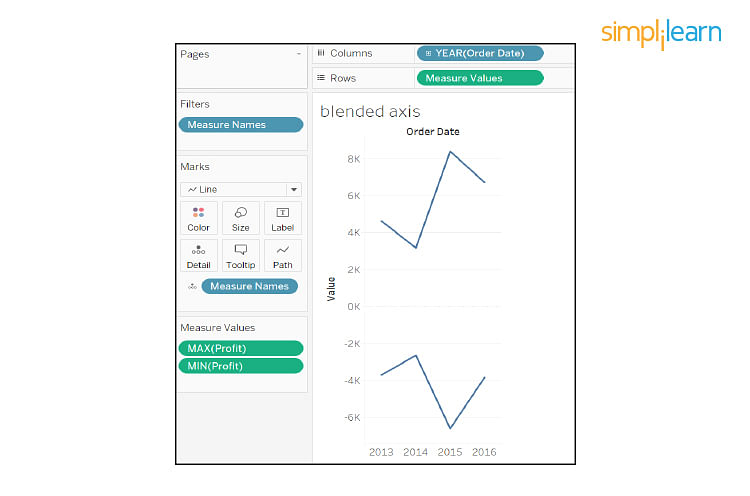
First, create a visualization that presentations gross sales over the years. Subsequent, see cash in in conjunction with gross sales over the similar time. Right here, you get two visualizations, one for gross sales over the years and the opposite for-profit over the years.
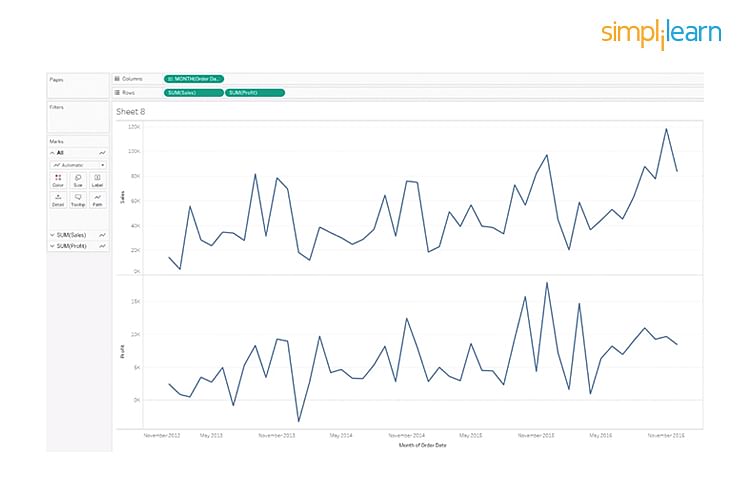
To peer a visualization that has a mixed axis for gross sales over the years and cash in over the years, we usher in Measure Values and make a selection the homes that we wish to stay (Gross sales and Benefit), taking out the entire leisure. You’ll now see cash in and gross sales over one mixed axis.

27. What’s the Use of Twin-axis? How Do You Create One?
Twin Axis permits you to evaluate measures, and this turns out to be useful when you wish to have to match two measures that experience other scales.
Taking into account the similar instance used within the above query, first create a visualization with gross sales over the years and cash in over the years. To create a dual-axis, right-click on the second one tablet of the measures and make a selection Twin Axis.
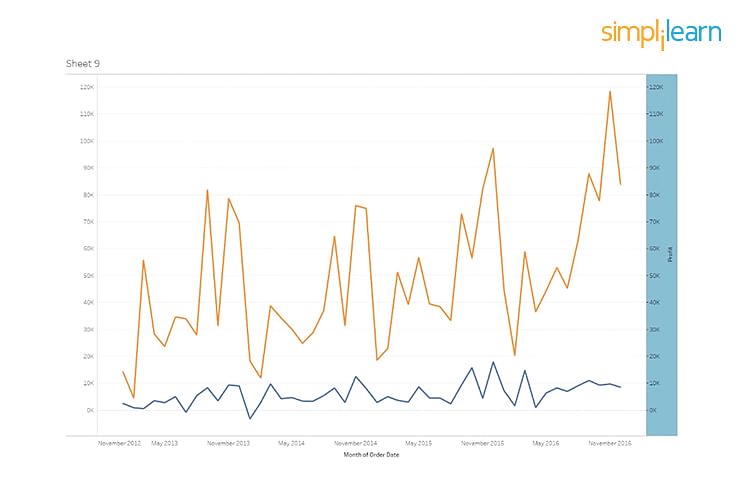
Apply that gross sales and cash in don’t proportion the similar axis, and cash in is way upper in opposition to the tip.
The variation between a mixed axis and a dual-axis chart is that the mixed axis makes use of the similar scale, whilst a dual-axis will have two other scales and two marks playing cards.
State of affairs: We wish to display Gross sales by way of 12 months and Benefit Ratio by way of 12 months in the similar view.
We create a visualization of gross sales over the years and cash in ratio over the years. Apply that gross sales and cash in ratio can’t use the similar scale because the cash in ratio is in proportion. As we wish the 2 parameters in the similar space, we right-click on Benefit Ratio and make a selection Twin Axis.
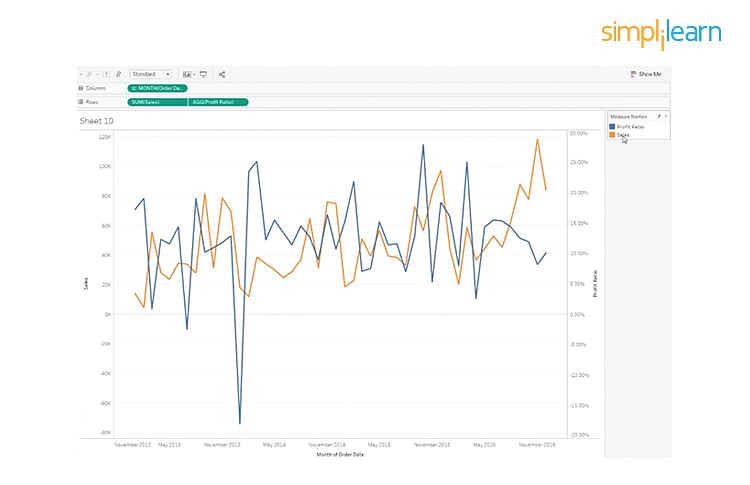
28. What Will the Following Serve as Go back?
Left(3, “Tableau”)
Select the proper solution:
- Tab
- Eau
- Error
- Not one of the above
It’s going to go back an error as a result of the proper syntax is: left(string, num_chars). So, it must be: Left(“Tableau,” 3)
Left returns a particular selection of characters from the beginning of the given string. If the proper syntax is adopted, the outcome could be ‘Tab.’
29. To find the Most sensible Product Subcategories by way of Gross sales Inside Every Supply Means. Which Subcategory Is Ranked #2 for Top quality Send Mode?
- First, draw a visualization the usage of send mode and subcategory.
- Subsequent, we take gross sales directly to the visualization as a rank desk calculation.
- Proper-click on Gross sales and make a selection Upload Desk Calculation and alter the Calculation Sort to Rank.
- Choose Desk Down, and also you get the knowledge as proven:
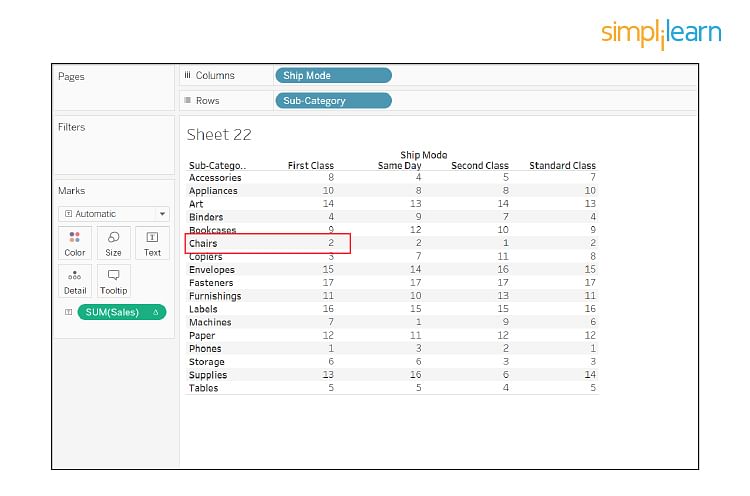
The chair is the subcategory, which is ranked #2 for the primary magnificence cargo mode.
30. What’s the Rank Serve as in Tableau?
The score is assigning one thing a place typically inside a class and in line with a measure. Tableau can rank in numerous tactics like:
- rank
- rank_dense
- rank_modified
- rank_unique
Imagine 5 shops whose gross sales are as proven:
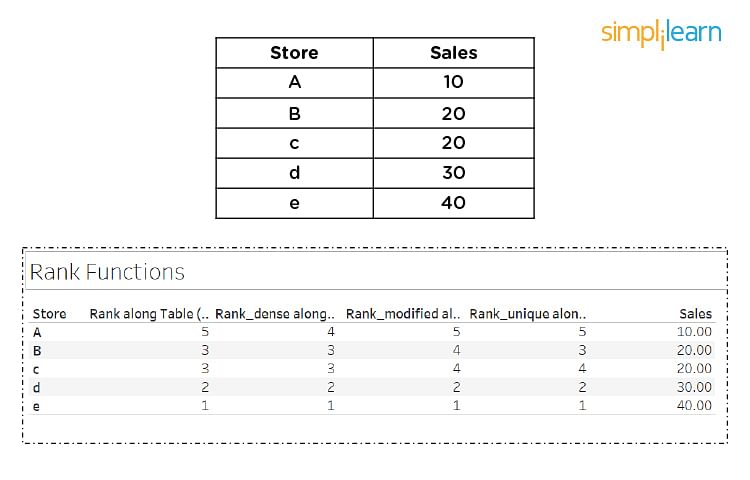
Allow us to know how they’re ranked in line with their gross sales:
- Drag Retailer box to Rows shelf and Gross sales box to the marks card.
- Create a Calculated Box named Rank and use the method: RANK (SUM(Gross sales))
- Convey the Rank box to the marks card.
- Double-click at the Rank box, and you’ll be able to see the rank assigned to the shops in line with gross sales.
Subsequent, reproduction the Rank box by way of right-clicking on it and deciding on Replica. Title the reproduction as ‘Rank Changed’ and use the method:
RANK MODIFIED (SUM(Gross sales))
Convey Rank Changed to the marks card to view the knowledge.
Repeat the similar steps to create ‘Rank Dense’ and use the method:
RANK DENSE (SUM(Gross sales))
In a similar way, create ‘Rank Distinctive’ and use the method:
RANK UNIQUE (SUM(Gross sales))
31. What Would You Do If Some Nations/Provinces (Any Geographical Entity) are Lacking and Exhibiting a Null When You Use Map View?
When operating with maps and geographical fields, unknown or ambiguous places are known by way of the indicator within the decrease correct nook of the view.
Click on the indicator and make a choice from the next choices:
- Edit Places – proper the places by way of mapping your records to recognized places
- Filter out Information – exclude the unknown places from the view the usage of a clear out. The places is probably not incorporated in calculations
- Display Information at Default Place – display the values on the default place of (0, 0) at the map.
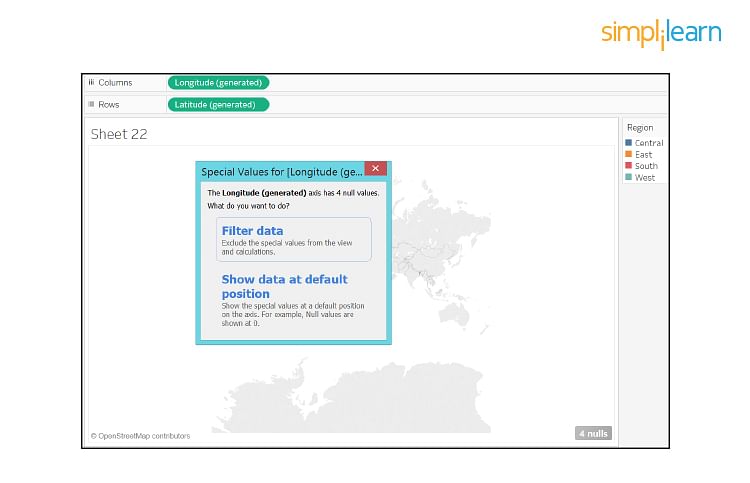
32. What’s the Degree of Element (LOD) Expression?
A degree of element expression is used to run advanced queries involving many dimensions on the records supply point as an alternative of bringing the entire records to Tableau interface.
Imagine a visualization as proven:
Right here, the scales are proven for a class like Furnishings and its sub-categories (Chairs, Tables, and many others.). To take a look at gross sales for the furnishings class as a complete and now not its sub-categories, take away the sub-category from the calculation box as proven:
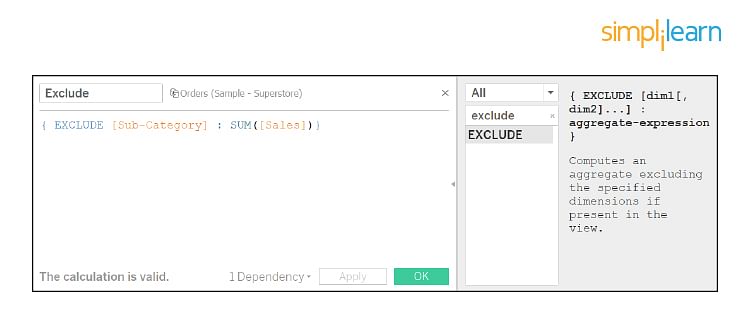
Now, the visualization looks as if:
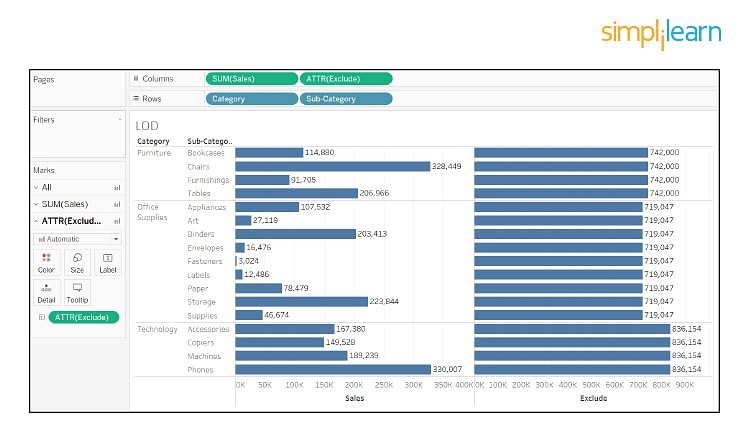
33. How Do You Calculate the Day by day Benefit Measures The use of LOD?
LOD expressions permit us to simply create packing containers on aggregated records equivalent to cash in in keeping with day.
State of affairs: We wish to measure our luck by way of the full cash in in keeping with trade day.
Create a calculated box named LOD – Benefit in keeping with day and input the method:
FIXED [Order Date] : SUM ([Profit])
Create every other calculated box named LOD – Day by day Benefit KPI and input the method:
IF [LOD – Profit per day] > 2000 then “Extremely Successful.”
ELSEIF [LOD – Profit per day] <= 0 then “Unprofitable”
ELSE “Successful”
END
To calculate day by day cash in measure the usage of LOD, apply those steps to attract the visualization:
- Convey YEAR(Order Date) and MONTH(Order Date) to the Columns shelf
- Drag Order Identification box to Rows shelf. Proper-click on it, make a selection Measure and click on on Rely(Distinct)
- Drag LOD – Day by day Benefit KPI to the Rows shelf
- Convey LOD – Day by day Benefit KPI to marks card and alter mark kind from automated to space.
The visualization is as proven:
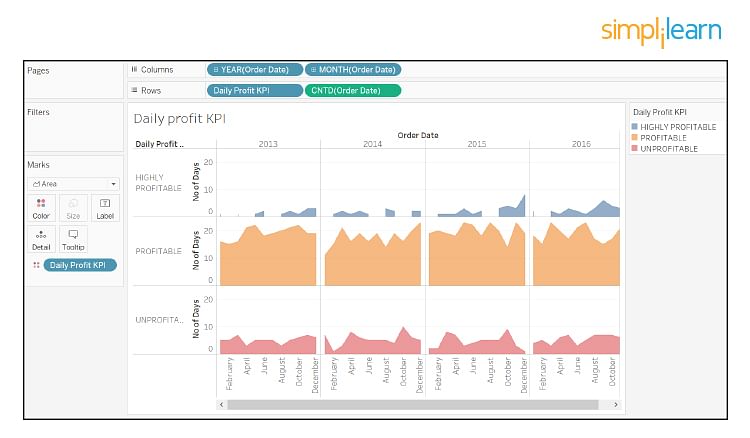
34. How Can You Agenda a Workbook in Tableau after Publishing It?
- While you’re signed in to Tableau Server, move to Content material > records assets or Content material > Workbooks, relying on the kind of content material you wish to have to refresh.
- Choose the checkbox for the knowledge supply or workbook you wish to have to refresh, after which make a selection Movements > Extract Refresh.
- Within the Refresh Extracts conversation, make a selection Agenda a Refresh, and whole the next steps:
- Choose the time table you wish to have.
- If to be had, specify whether or not you wish to have a complete or incremental refresh.
35. What Are the Other Kinds of Tableau?
The various kinds of Tableau are Desktop, Prep, On-line, and Server.
State of affairs-based Tableau Interview Questions
36. How Do You Maintain Null and Different Particular Values?
If the sphere comprises null values or if there are zeros or unfavourable values on a logarithmic axis, Tableau can’t plot them. Tableau presentations a hallmark within the decrease correct nook of the view, and you’ll be able to click on the indicator and make a choice from the next choices:
- Filter out Information
Excludes the null values from the visualization the usage of a clear out. If that’s the case, the null values also are excluded from any calculations used within the view. - Display Information at Default Place
Displays the knowledge at a default location at the axis.
37. To find the Buyer with the Lowest General Benefit. What’s Their Benefit Ratio?
Draw a visualization between Consumers and their cash in and kind it from smallest to largest.
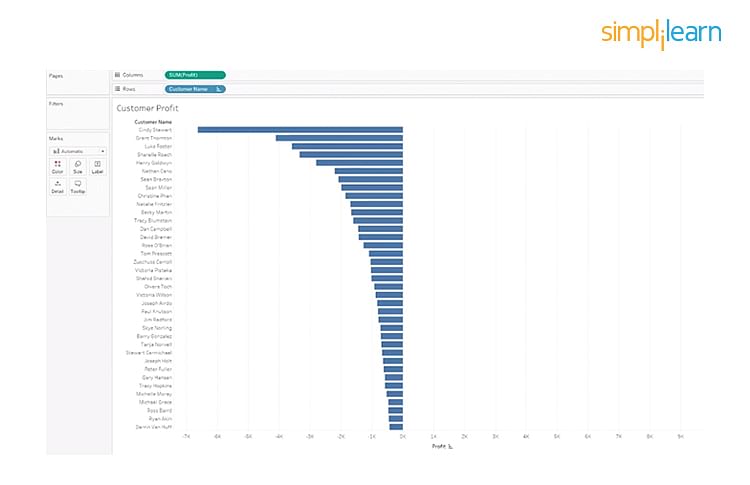
Right here, Cindy Stewart is the person who has the bottom cash in. To resolve her cash in ratio:
- Create a calculated box named Benefit Ratio.
- Proper-click on Benefit Ratio below Measures and make a selection Edit.
- Input the method: SUM (PROFIT) / SUM (SALES)
- Subsequent, drag the Benefit Ratio to the Label to determine Cindy’s cash in ratio.
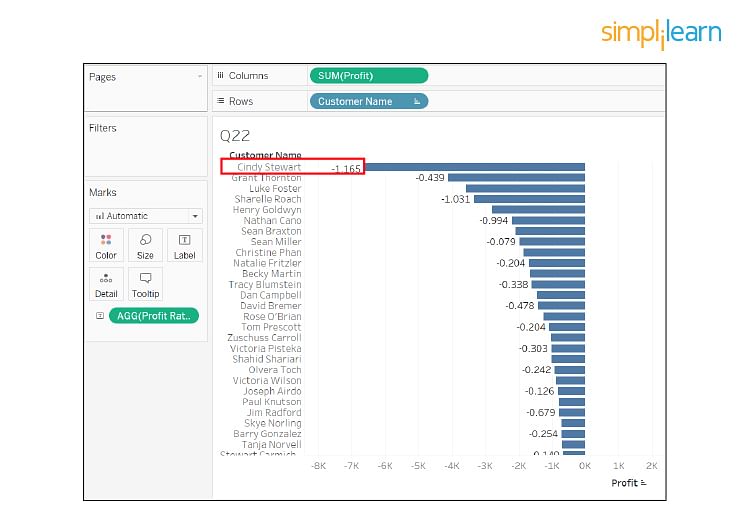
38. How Can You Embed a Webpage in a Dashboard?
Practice those easy steps to embed a webpage in a dashboard:
- Move to dashboard
- Double click on the ‘Webpage’ possibility to be had below ‘Items.’
- Input the URL (right here https://en.m.wikipedia.org/wiki/) of the webpage within the conversation field that looks
You’ll see the webpage seems at the dashboard.
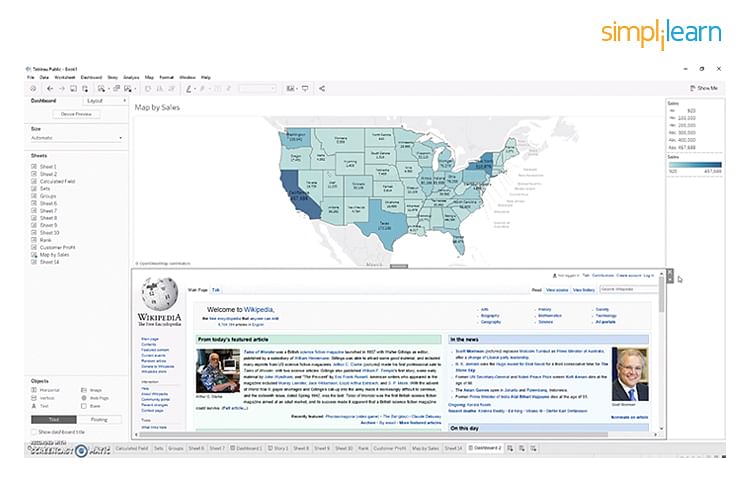
39. How Do You Make the Webpage Dynamic?
Start by way of bringing Map by way of Gross sales into view. It presentations the state’s title and its gross sales.
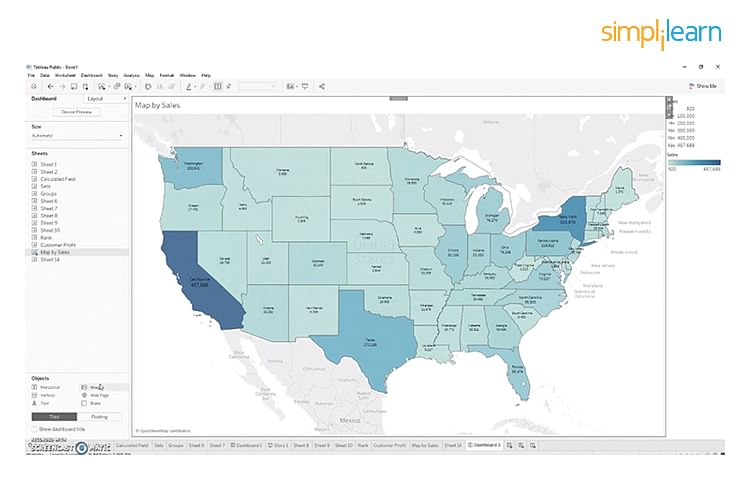
- Move to the dashboard.
- Double click on the ‘Webpage’ possibility to be had below ‘Items.’
- Don’t supply a URL within the conversation field that looks and click on on Good enough.
- Click on at the Dashboard within the menu and make a selection ‘Motion.’
- Click on on ‘Upload Motion ’ and make a selection ‘Move to URL.’
- Input ‘ below the URL possibility. Click on at the arrow adjoining to it and make a selection ‘State.’
- Click on on ‘Choose possibility’ and hit ‘Good enough.’
Now, while you click on on any state like California, it brings up the California Wikipedia web page. That is the right way to make it dynamic.
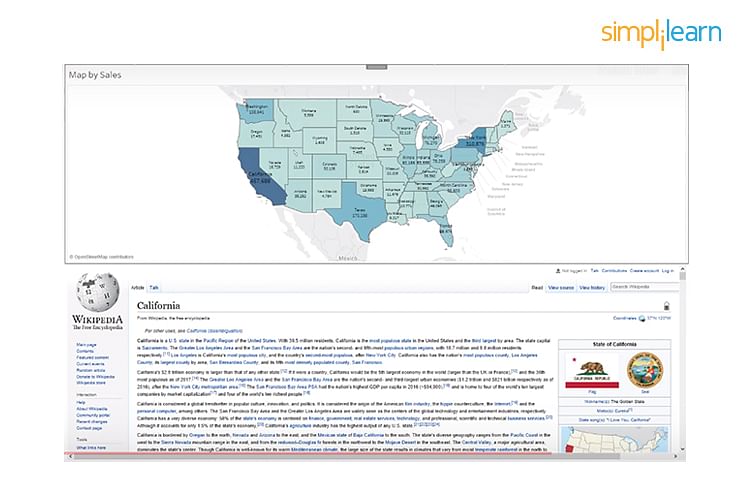
40. Design a View to Display Area Smart Benefit and Gross sales.
Practice those easy steps to turn area smart cash in and gross sales:
- Drag Benefit and Gross sales box to the Rows shelf
- Drag Area box to the Columns shelf
However for such Tableau interview questions, the interviewer could also be on the lookout for your mapping functions in Tableau. So, you want to apply those steps to turn area smart cash in and gross sales in a greater approach:
- Double click on at the State box to get its view
- Move to Marks card and alter the mark kind from Computerized to Map.
- Convey Area box to Colour at the Marks card
- Drag Benefit, Gross sales, and State fields to Label at the Marks card
Those steps produce a greater view of region-wise cash in and gross sales, as proven:
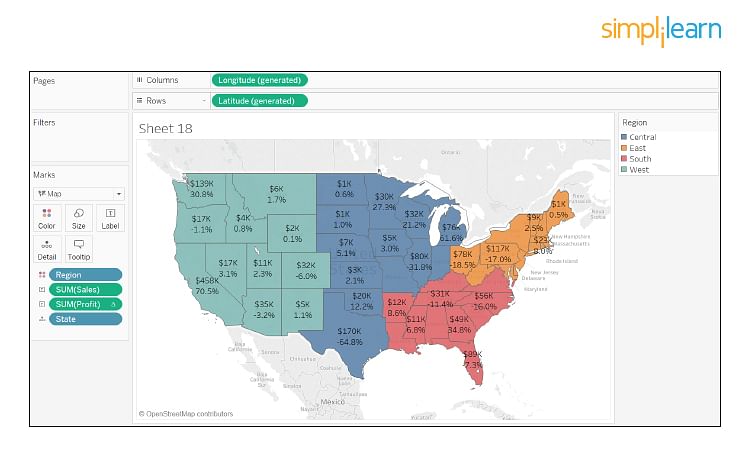
41. How Can You Optimize the Efficiency of a Dashboard?
There are a number of tactics to optimize the efficiency of the dashboard like:
- Maximize the selection of fields and information. You’ll exclude unused fields out of your visualization or use extract filters.
- Restrict the selection of filters used, by way of averting fast filters and the usage of motion and parameter filters as an alternative. Those filters cut back question quite a bit.
- use Min/Max as an alternative of Reasonable as a result of reasonable purposes require extra processing time than Min/Max
- Use boolean or numerical calculations greater than string calculations. Computer systems can procedure integers and boolean a lot quicker than strings.
Boolean > int > go with the flow > date-time > string
42. Which Visualization Will Be Used within the given Situations?
- To turn aggregated gross sales totals throughout a spread of product classes and subcategories
- To turn the length of occasions or actions
- To turn quarter smart cash in enlargement
We’d use the next visualizations for the given eventualities:
- Treemap
- Gantt chart
- Waterfall chart
Further Tableau Interview Questions
43. What does it imply to records visualization?
Information visualisation is the method of unveiling records or knowledge visually. We will use graphs, charts, bars, and plenty of extra issues which are simple to peer. Information visualisation equipment make it simple to have a look at and perceive the knowledge.
44. What do Measures and Dimensions imply?
Measures and Dimensions are portions of a Tableau dataset that describe it.
Measures are quantities of information that may be counted and analysed in opposition to dimensions. Dimensions resolve what number of measures can also be added to a unmarried string. For instance, a web-based store’s stock can checklist the selection of pieces, their costs, the selection of issues offered previously, how they’re paid for, and many others. All of those can also be regarded as steps.
However, dimensions are simply descriptions that make it conceivable to peer one thing. They let a consumer say various things a couple of unmarried metric. All of those descriptions make up a size desk.
45. Give an explanation for why records servers are very important in Tableau.
In Tableau, an information server has two jobs to do. One, it permits you to stay your records, like datasets, previous calculations, aliases, and definitions, in sync with the server in an effort to get right of entry to it from any place. This makes it conceivable to do any job extra truthfully. So, it provides you with safety and fast get right of entry to.
2nd, in case you have an information server, you’ll be able to obtain probably the most records you want to a neighborhood device to run a visualisation or file. During the server, it’s simple to get from the web.
46. What is a heatmap? Describe a case.
A heatmap is one of those records visualisation that makes use of other sun shades of colors to turn an information set. The darkest color of a selected color presentations an excessive cost (top depth or density). In most cases, it’s used to match two or extra measurements.
A handy guide a rough approach to make use of a heatmap could be to be told in regards to the human frame’s construction and spot how heat it’s in line with the temperature of various organs. If the pink and yellow colors are used, the pink portions will display the place the temperature is the best possible.
47. In Tableau, what are aggregation and disaggregation?
Aggregation is the easy concept of taking the typical of the values in a given column of an information set. If a file presentations how the cost of a product has modified over the years, aggregation can assist to find its reasonable cost. More often than not, Tableau routinely teams a suite of information.
The other of averaging is disaggregation, which can also be useful if a consumer needs to have a look at every records level one by one. You’ll additionally use each grouped and ungrouped records in the similar worksheet.
48. Inform the adaptation between discrete and steady.
There are two forms of size float in Tableau. They’re discrete and steady.
Discrete values are unmarried issues counted one by one from a bunch of different problems. The selection of states in a rustic is one instance.
Steady values let the consumer use values in a spread that may be both finite or endless—as an example, how an organization’s inventory worth adjustments.
49. Give a tale about Tableau for instance
A tale is a suite of worksheets or dashboards that paintings in combination to inform a message.
An instance of this may be striking in combination two worksheets appearing how smartly an organization’s workers are doing. On one worksheet, there are efficiency metrics and summaries for workers in ranges L1 via L3. On the identical time, the similar knowledge can also be discovered on the second one worksheet for workers in ranges L3 and L4 (higher control). Since every worker’s efficiency will depend on the others’ efficiency, this can provide a big-picture view of the way smartly the corporate’s workers are doing as a complete.
That is used when the worksheets have other parameters and measures.
50. In Tableau, what’s a context clear out?
Context Filters can fortify the dashboard’s view when multiple clear out is used. A clear out in Tableau works on each row within the dataset, it doesn’t matter what different filters are in position. By means of utilising a context clear out, we will be able to minimize down at the dimension of the dataset. The remainder of the filters will then be run at the smaller dataset, lowering the time it takes.
51. In Tableau, what’s KPI?
By means of the usage of the Key Efficiency Signs in Shapes card, Tableau makes it more straightforward to have a look at how smartly an organization is doing in line with some key signs:
- Create a calculated box and mark the values as a success or unsuccessful in line with the desired parameter.
- Make a chart the usage of a size and the calculated box you simply made. Within the marks card, exchange routinely to shapes.
- Put luck and failure at the KPI shapes card to make issues more straightforward to grasp.
52. How one can make a doughnut chart in Tableau?
Tableau does not have a right away strategy to make a donut chart, however there are two tactics to do it. If you wish to display a donut chart on a sheet, you must make a pie chart and upload every other measure to the rows shelf. Now you’ll be able to see two pie charts at the sheet. Exchange the second one pie chart’s color to check the background and make it smaller. Then, right-click on the second one example within the rows shelf and select “twin axis.” In the end, take away any main points that are not wanted. The second one strategy to make a donut chart will most effective paintings in a dashboard. First, create a pie chart in a sheet and import it to the dashboard. Then, put a spherical symbol within the center that’s the identical color because the background.
53. What’s a tableau server?
Tableau server is used to organise, edit, proportion, and paintings in combination on Tableau dashboards made at the Tableau desktop. It is more secure for organisations since the records will most effective be observed by way of individuals who paintings there, and the administrator can make a decision how a lot keep watch over every consumer has. For instance, a consumer would possibly most effective have the ability to view the knowledge, or most effective have the ability to edit it, or each.
54. What does bin imply in Tableau?
In Tableau, packing containers are packing containers of the similar dimension used to retailer records values that are compatible within the dimension of the bin. In different phrases, packing containers divide the knowledge into teams of the similar dimension, which can be utilized to have a look at the knowledge systematically. All of Tableau’s discrete fields can also be regarded as “packing containers” as an alternative.
55. In Tableau, what’s research?
Tableau has integrated equipment that can assist you analyse the knowledge on a chart. We now have a number of equipment, equivalent to including a median line to a chart. When we drop the device at the chart, Tableau does the maths. There also are equipment to discover and check up on records, equivalent to clustering, percentages, making bands of a particular dimension, and extra. Those equipment can also be discovered at the “Analyze” tab of each sheet used to create a chart. The options most effective display up when they are able to be used at the worksheet.
56. How do I make units in tableau?
Units are customized fields that permit you to evaluate and ask questions on a subset of information. To make a suite on a size, right-click on a dimension within the records pane and select to create > set. At the “Common” tab, make a selection the fields used to determine the set. At the stipulations tab, you’ll be able to set the stipulations for making a suite. At the height tab, you’ll be able to additionally select the highest N participants of the dataset in line with any box. When a suite is made, the measure is divided into two portions, “in” and “out” of the set, in line with the consumer’s stipulations.
57. In Tableau, what’s the fast clear out?
While you use a clear out in Tableau, you’ll be able to simply exchange the way it works. For instance, you’ll be able to use it as a single-value drop-down checklist, a single-value checklist, a multiple-value checklist, a multiple-value drop-down checklist, or one thing else. Once we upload a clear out to a sheet, we will be able to right-click at the sheet to peer the entire fast clear out choices. For those who exchange any of those choices, the way in which the clear out appears to be like at the sheet may also exchange.
58. What’s the tableau desktop?
Tableau Desktop is a product made by way of Tableau this is used to create, edit, and retailer records visualisations in the neighborhood on a machine. You’ll post the visualisations to a server, on-line, or to the general public after they’re executed or perhaps even in the course of the method. Tableau Desktop customers too can edit any document made on every other machine in the similar or a decrease model of Tableau.
59. What does “web page shelf” imply in Tableau?
Web page shelf in Tableau makes it more straightforward to grasp and use a number of charts. If there’s multiple plot on a unmarried sheet and you wish to have to peer them one after the other, drag and drop the size that makes multiple chart onto the web page shelf. Then, a button at the correct aspect shall we us have a look at the knowledge one chart at a time.
60. How to determine the share in Tableau?
To determine how a lot of your worksheet’s records it comprises. To get right of entry to proportion breakdowns, make a selection Analyze > Percentages within the left-hand pane. Many different proportion breakdowns are to be had there, equivalent to the share of the desk, row, column, row in pane, pane, column in pane, and mobile. Select one of the vital choices above, after which set the full quantity for which the share is to be calculated. There is not any strategy to give other choices to rows and columns. The choice you select would be the identical for all rows and columns.
61. What does “tableau developer” imply?
A tableau developer is aware of the right way to take uncooked records and use it to make records visualisations and get precious insights. A tableau developer must have the ability to make complex dashboards which are simple for other folks to make use of and assist them simply perceive the knowledge.
62. What’s a tableau records engine?
The in-memory Information Engine utilized by Tableau is known as Hyper. It makes it more straightforward to import records and analyse it temporarily. It shall we the consumer make an extract document of an information set, which can also be thought to be a smaller model of the dataset that also has the entire records. This makes it quicker to run other queries at the dataset. It makes it more straightforward for the consumer to paintings with huge datasets.
63. What is the distinction between Energy Bi and Tableau?
Tableau does a greater task with huge records units than Energy Bi .Tableau’s customer support is best for each loose and paid customers, whilst Energy Bi’s customer support is just for paid customers. Tableau’s server-side garage and a number of data-source connectivities are two of its maximum interesting options. Energy Bi, then again, can most effective hook up with a restricted selection of records assets and focuses extra on reporting and analytical modelling than on storing records. In comparison to Tableau, Energy Bi has a greater graphical consumer interface. Additionally it is simple to make use of.
64. How do I conceal the dashboard in Tableau?
Tableau does not have a strategy to conceal a dashboard, however should you post the dashboard to a site, you’ll be able to set a command to turn the dashboard most effective when a selected button is clicked. You’ll additionally conceal sheets as an alternative of dashboards prior to publishing the dashboard. In order that when folks first have a look at your viz, they just see the dashboard and now not the person sheets.
65. How do I exploit teams in calculated fields in Tableau?
You’ll make a bunch by way of right-clicking on a box within the records pane and opting for “Create” > “Staff.” Then, you’ll be able to make a selection the fields you wish to have to team below the “Common” tab and set the standards for grouping below the “Stipulations” tab. Then, right-click in this team and select “create,” “set,” and “create a calculated box.” You’ll then use this team as a suite on this calculated box.
66. How one can make hierarchy in Tableau?
Tableau creates an information supply hierarchy in line with the values within the fields by way of default. You’ll make your hierarchy in some way that matches your wishes. Drag a box at the height of every other box within the Information pane. When induced, kind the title of the hierarchy and press OK. After that, you’ll be able to additionally upload extra fields to the hierarchy. By means of creating a hierarchy, you’ll be able to temporarily transfer between the knowledge classes you will have made, that may be in line with location, like nation, state, town, or area.
67. How do I hyperlink R and Tableau?
First, obtain and set up R to your pc. Then, use the command set up.programs(“Rserve”) to put in a package deal referred to as Rserve. As soon as Rserve is put in, you’ll be able to do that step most effective infrequently you wish to have to make use of R from Tableau. The next steps, then again, should be executed each time you need to hyperlink R to Tableau. Now, use the command library (Rserve) to deliver the library into the present operating atmosphere, after which kind Rserve() within the command window to attach R with Tableau. Now, move to Tableau’s assist menu and select “Arrange R connection.” Input “Localhost” because the server title and “6311” because the port. Click on the “Take a look at Connection” button to verify the entirety is operating as it should be, and click on “OK” to near the window.
68. What cannot be executed with Tableau?
Tableau is basically used for visualising records, so it most effective does a small quantity of pre-processing. When opened on a display with a unique answer, dashboards glance other. The cost of Tableau may be top, and they do not be offering any plans adapted to the wishes of companies. Customers who use Tableau totally free and publish their paintings on Tableau Public could cause safety issues as a result of Tableau Public does not offer protection to uploaded information.
69. Why do you want records aggregation or disaggregation to make charts in Tableau?
Relying on what the consumer needs, aggregation and disaggregation inform Tableau the right way to mix records. To make a chart, it should meet particular necessities, equivalent to having one or two dimensions and one or two measures. And for measures, you’ve to select the aggregation, equivalent to sum, median, reasonable, and many others., or the entire values might be proven as sum by way of default. And the individual the usage of the chart would possibly wish to see one thing other. So, it is very important to make use of the correct manner of aggregation or, if important, to get a divorce the knowledge.
70. How does customized SQL paintings in Tableau?
Customers can get the tips they want with the assistance of a customized SQL. You’ll write your personal SQL question while you attach Tableau to a knowledge supply. As soon as you are hooked up to a knowledge supply, at the records supply web page, double-click the “New Customized SQL” possibility. Then kind the SQL question or reproduction and paste it into the textual content field, and when you find yourself executed, click on OK.
71. How do I hyperlink MongoDB to Tableau?
To hook up with Mongodb, chances are you’ll want an additional driving force. I counsel you get the driving force from and set up it. As soon as it is put in, open Tableau and select “Attach” > “Mongodb BI connector.” If you’ll be able to’t to find it in the primary checklist, you’ll be able to to find it below “To a server” > “Extra” > “Mongodb BI connector.” Then, kind within the server’s title, consumer title, and password for the database that is going with it. While you hook up with an SSL server, take a look at the “Require SSL” field. Then click on “Check in.” The knowledge supply is now able to move.
72. In Tableau, what’s a cascading clear out?
Cascading filters may also be regarded as giving precedence to 1 clear out after which the usage of different filters on an information supply that has already been filtered. Proper-click at the clear out you wish to have to make use of as the main clear out and make sure it’s set to “all values” within the dashboard. Then, make a selection the next clear out and select most effective the related values to cascade the filters. This may increasingly fortify the dashboard as a result of you’ve lowered the time wasted working the entire filters over the entire records supply.
73. What’s the “Tableau Reporting Device”?
Making a dashboard may be a type of reporting as a result of as soon as you are executed designing the dashboards to fulfill the buyer’s wishes, they are able to be utilized in ppt, pdf, or another required document kind, so long as they are suitable with the view you will have made. Those interactive dashboards permit the buyer to set the filters and parameters to peer customized charts in numerous scenarios.
74. What does “view in tableau” imply?
The time period “view” refers to how records from a supply is proven in a worksheet. A view can also be anything else. It is usually a plot, a chart, a graph, or perhaps a desk. Then, all of those issues of view are put in combination on a dashboard to make a unmarried tale and display how all of them are compatible in combination.
75. How can I make Tableau paintings higher?
There are lots of tactics to fortify efficiency, however one of the vital most simple is to make use of the “extract” possibility at the records supply. This is likely one of the most efficient tactics to fortify efficiency. As soon as you are executed making dashboards, run the efficiency recorder from the assist menu. It’s going to inform you which sheets are slowing down your Tableau and why. You must attempt to decrease the marks. Take a look at the usage of fewer filters, or if you want to, use the come with box as an alternative of the exclude box. Use the context clear out to type via huge quantities of information, and take a look at to make use of cascade filters to chop down at the time it takes for a question to run.
76. In Tableau, what’s a workbook?
A workbook is a whole set of sheets, dashboards, and tales you’ve made on tableau desktop or public, stored to your native machine or revealed on tableau public. You’ll get the workbook for tableau public by way of clicking at the hyperlink to its site.
77. What’s the maximum miniature model of the Android running machine that can be utilized with tableau cellular?
Tableau cellular works on gadgets that experience Android 7 or upper. Visualisations made at the tableau desktop, tableau server, or Tableau on-line can also be considered on tableau cellular.
78. What do “are living” and “extract” imply in Tableau?
The extract is a snapshot of the knowledge arrange so it may be added up. Extracts are loaded into the machine, which makes Tableau run higher. While extracts may not assist when records is repeatedly up to date as a result of we need to manually refresh the knowledge for every exchange, a are living connection would possibly decelerate the processing. Nonetheless, it’s going to replace the knowledge supply itself. So, you must most effective use a are living connection when records is repeatedly being modified. Differently, you need to use an extract document.
79. In Tableau, what’s a scatter plot?
A scatter plot presentations how two or extra measures, without or with dimensions, relate to one another. To make a scatter plot, you want a minimum of one measure in every row and column. You’ll then use other dimensions so as to add extra main points—marks over color and knowledge at the card. In a scatter plot, the knowledge issues are drawn in an area, and their shapes rely at the values within the measures.
80. What are cycle fields in Tableau used for?
Cycle fields permit you to attempt to transfer between other color mixtures or perspectives in a loop. It’s going to most effective paintings if now we have a chart appearing multiple measure, like a stacked bar chart, and we will be able to’t end the visualisations. If that’s the case, we will be able to use cycle fields. To make use of the cycle box, move to the toolbar and click on at the research menu. Then, click on on cycle fields to temporarily have a look at a unique strategy to show the knowledge.
81. In Tableau, what are marks?
A Marks card is helping upload main points to the chart as it can provide other colors in line with a class and alter the scale of a line, circle, or bar within the chart in line with any measured cost. Marks card may be used to position labels at the chart and upload main points to the view. Additionally it is used to keep watch over the tooltip and the way it appears to be like, which must fortify the visualisations.
82. How do you attach Tableau for your site?
A developer wishes to understand the entirety about Tableau’s Javascript API to attach Tableau to a site. It permits you to read about and manipulate a Tableau spreadsheet or dashboard with out ever having to depart the benefit of your browser. Tableau has given a whole checklist of the entire purposes used within the Javascript API. One of the most very important purposes also are proven how for use within the loose instructional segment. When revealed on Tableau Public, Tableau On-line, or Tableau Server, all dashboards and worksheets are routinely related to the Javascript API. A developer most effective wishes to name that API in HTML code to begin interacting with it.
83. How do I show an axis in Tableau?
You’ll select whether or not to turn or conceal an axis. To cover the axis, right-click at the axis and uncheck “Display header.” To deliver again the hidden axis, right-click at the fields in a row or column and select “display header.”
84. How do I upload a symbol to the dashboard in Tableau?
Within the dashboard gadgets pane, there’s a option to import a picture. Be sure to have selected the floating kind as an alternative of the tiled kind, which is the default. Drag the picture object to the dashboard, and make a selection the emblem you stored to your pc in .png, .jpg, or.jpeg layout. Customers can use the small drop-down menu at the correct aspect of the picture and select “Ship to Again” to make use of it as a background. They may be able to then make it larger to make use of as a watermark brand.
85. What is the distinction between .twb document and .twbx extension?
A.twb document has details about the entire sheets, dashboards, and tales however must be about the place the knowledge got here from. The .twbx document, then again, has the entire sheets, tales, dashboards, and compressed records assets. The knowledge supply must have an a.twbx extract executed to avoid wasting. If we ship an a.twb document to any individual else, they are going to have the ability to have a look at the worksheets and dashboards however now not the dataset.
86. How do I blank up my records in Tableau?
On the height or backside of an information document, there could also be an outline of what the document is ready. Tableau will not be able to make sense of the knowledge in its present shape. After connecting to the knowledge document, you want to show at the records interpreter within the left panel. It’s going to get rid of the undesirable rows from the knowledge supply in Tableau with out converting the document the knowledge is coming from.
87. How do I post Tableau experiences to Tableau Server?
Open the workbook you wish to have to post to Tableau Server. Be sure to are on a operating sheet that might be despatched to the server. If you do not, you will not be able to peer “Post Workbook” within the toolbar’s “Server” menu. After you click on “Post Workbook,” check in for your tableau server account and provides it the title you wish to have it to have at the server.
88. In Tableau, what does it imply to think referential integrity?
While you know that two records assets have the similar references in a column, you’ll be able to use the “think referential integrity” possibility. Then, you’ll be able to use the function “think referential integrity” to outline the connection between the 2 records assets and “sign up for” them. To enforce referential integrity, drop the second one desk at the aspect of the primary desk. It’s going to then ask you to check the column to accomplish the sign up for, and then you’ll be able to select the reference column, and Tableau will carry out the sign up for in line with the reference and form of sign up for.
89. How do I make a bunch in Tableau?
Other folks in the similar box are put in combination in a bunch. You’ll create teams in numerous tactics, together with deciding on records within the view or from so much within the Information pane. When you choose a number of records issues in view, the tooltip will display an way to team. You’ll use this way to create a bunch or right-click on a box within the Information pane and select to Create > Staff. Now you’ll be able to make a selection a couple of participants you wish to have to team and click on the gang button.
90. How do I exploit Tableau to make a longitude and latitude?
Tableau makes it really easy to get longitude and latitude. Drag and drop international locations, states, towns, or another geographical box into the view, and Tableau will routinely plot the puts at the map. Then, select the entire records issues, right-click, and make a selection “view records.” At the tab referred to as “View Information,” you’ll be able to see the generated longitude and latitude subsequent to the rustic title. You’ll additionally export this knowledge from Tableau to make use of in every other programme or every other records supply.
Face the Tableau Interview Questions Like a Professional
The most efficient time to organize for that all-important Tableau task interview is prior to you even get started on the lookout for a task. By means of taking part in consumer teams, publishing your paintings, and doing the opposite actions prompt on this Tableau Interview Questions article, you’ll lay the groundwork for a greater task interview by way of being extra ready but additionally by way of having tangible evidence of your efforts.
Certification is likely one of the best possible tactics to organize for a Tableau task interview should you’re nonetheless rather new to the analytics box. And Simplilearn has the correct certification program for you. The Simplilearn Caltech Publish Graduate Program in Information Science direction will educate you the ideas of Tableau Desktop 10 as you change into gifted with Tableau statistics and construct interactive dashboards. Additionally, you’ll learn how to grasp records assets, create records extracts, and prepare and layout records in addition to be informed visualization and information research tactics, amongst many different talents. This Tableau coaching is designed for execs in quest of to begin to advance a occupation in records analytics, in addition to trade customers who wish to broaden Tableau skillability. The direction may also get ready you to stand any more or less Tableau interview questions and reveal your talents.
And if in case you have any questions on those tableau interview questions, drop a remark underneath, and our professionals gets again to you immediately!












